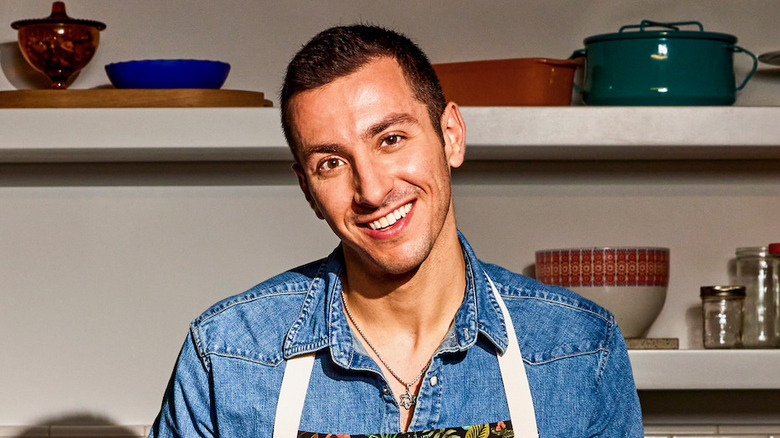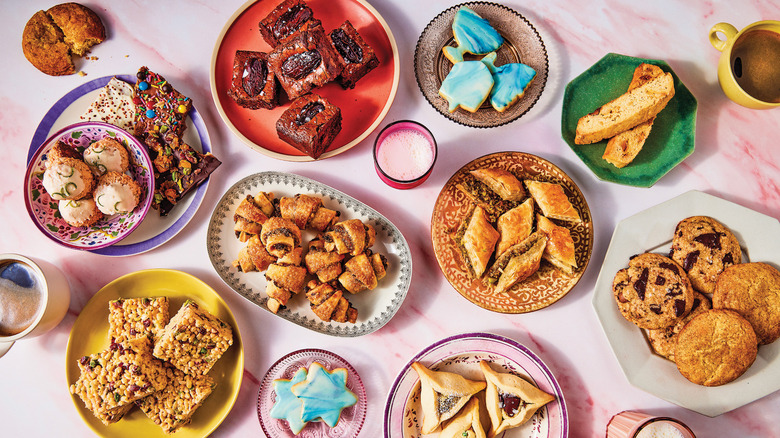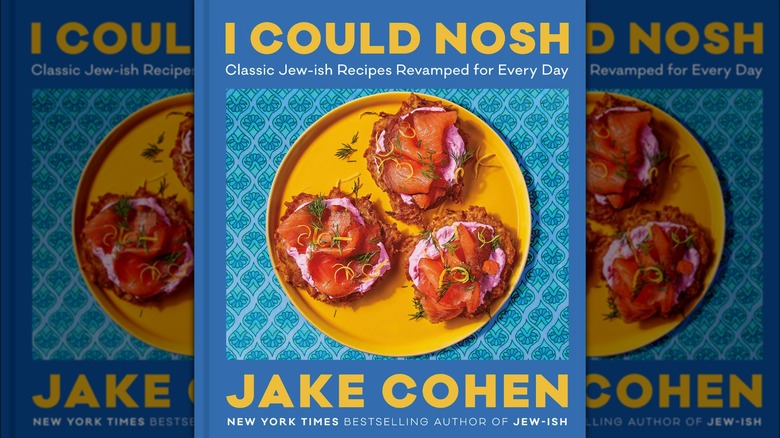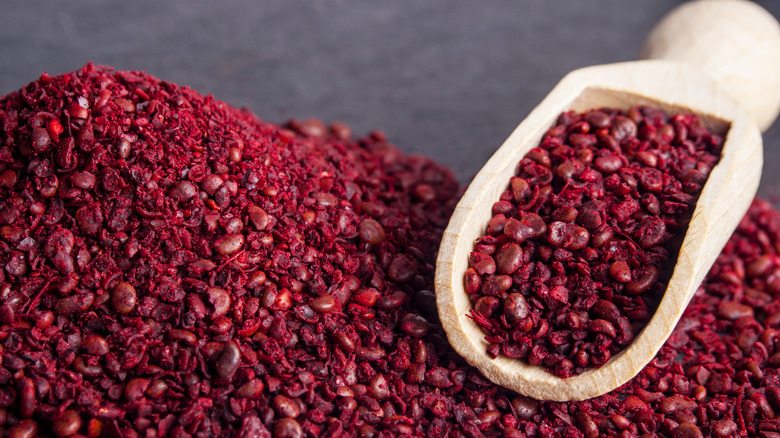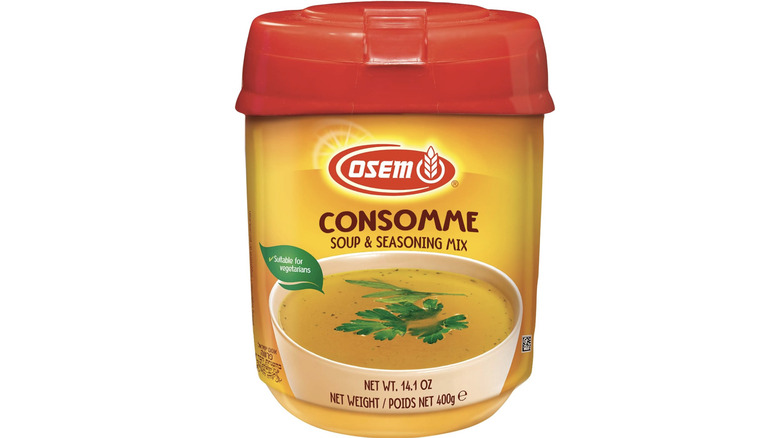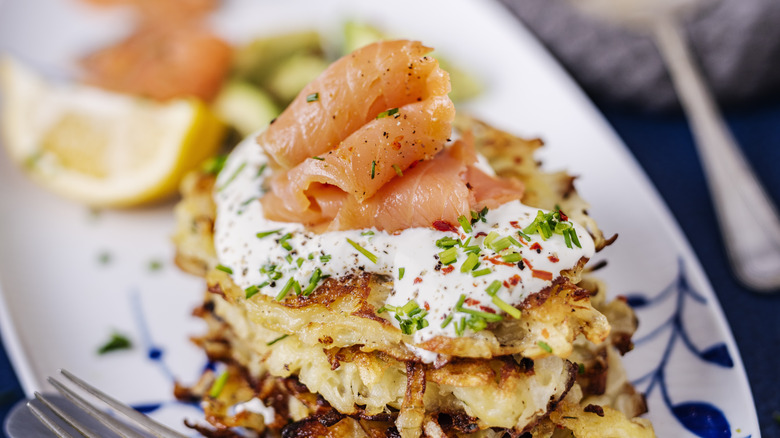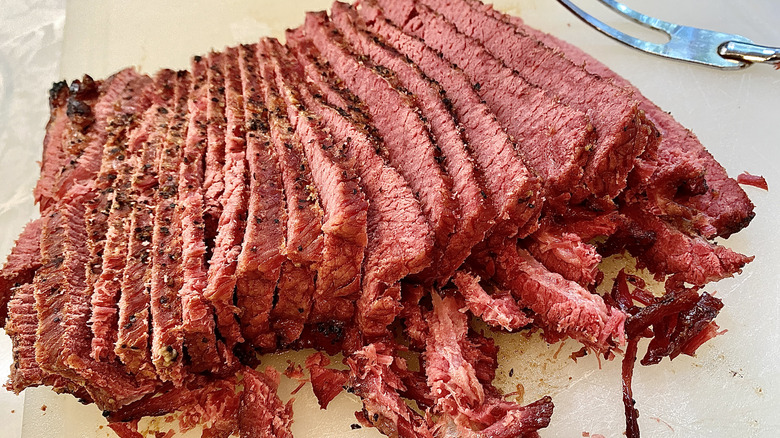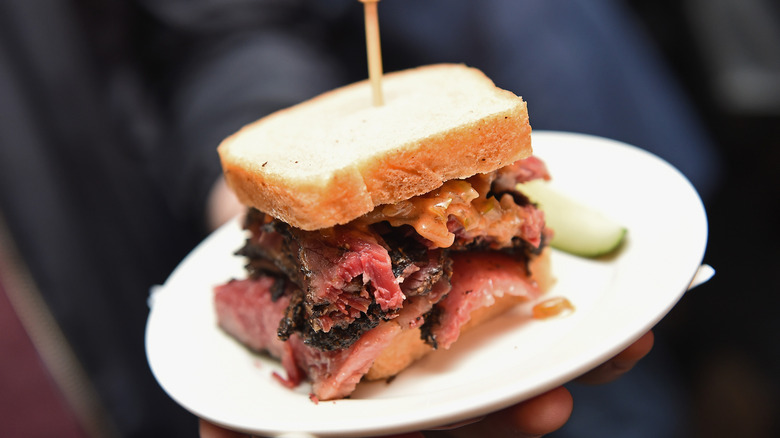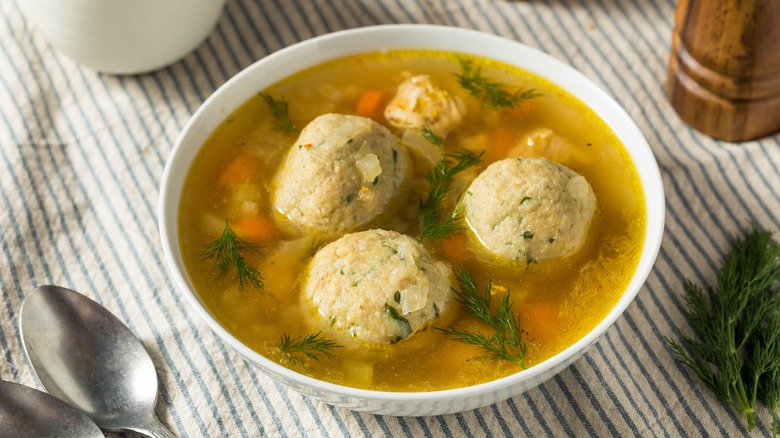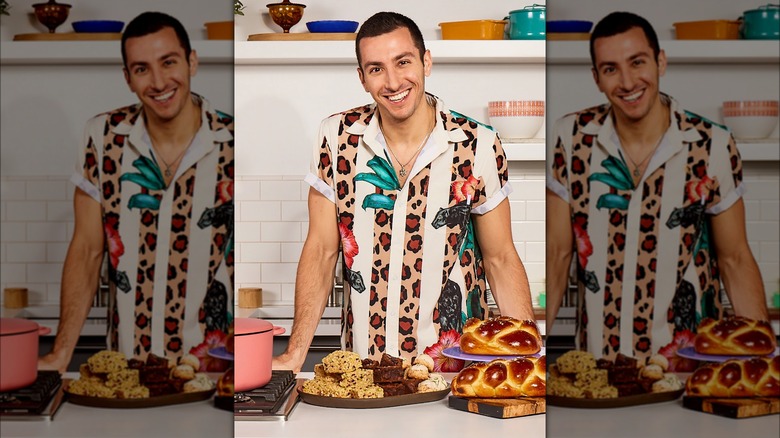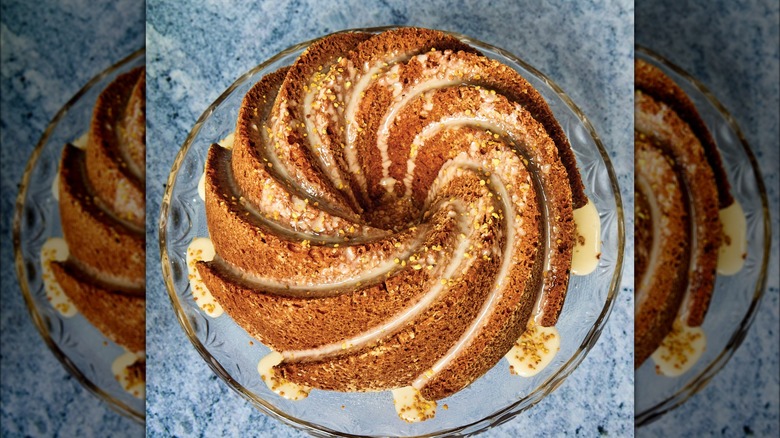Jake Cohen Talks To Us About His New Cookbook And Shares Jewish Cooking Secrets - Exclusive Interview
Cookbook author (and former Tasting Table food editor) Jake Cohen made a big splash with his first cookbook, "Jew-Ish," which puts a playful, modern spin on classic Jewish celebratory recipes. He has also racked up an impressive one million-plus followers on Instagram with his mouthwatering posts about making challah and other goodies. Now, he's putting out a hotly anticipated second book entitled "I Could Nosh."
The new book takes the same respectful yet irreverent approach to Jewish food traditions as its predecessor, but it focuses more on recipes you can use for everyday entertaining rather than big special-event meals. In an exclusive interview with Tasting Table, Cohen talked about what to expect from "I Could Nosh" and shared tips about making Jewish foods like corned beef, matzo ball soup, and latkes at home.
As you might predict, he also talked about adding some unexpected twists to traditional recipes — have you ever thought about making sugar-dusted latkes before? What about seasoning brownies with sumac? Whether you're looking to spice up your next Shabbat dinner or seeking to explore Jewish cuisine for the first time, Cohen has a wealth of wisdom.
How to host an easy dinner party
You talk about entertaining a lot in "I Could Nosh." What are your cooking rules or best practices for a stress-free dinner party?
I refer to my rule as "Kitchen Dayenu" — "Dayenu" is the song from Passover where it goes through all of the miracles of the Exodus and saying, "Well, if only one of them happened, it would've been enough." It's all about gratitude.
My internalization of that in the kitchen is that whatever you do, it will be enough. If that means that you don't do the apps and just buy a bunch of nice cheeses from the store, or you don't make the dessert and you have someone else bring it, or you do X, Y, Z ... Whatever you need to keep your peace of mind, that's what you need to do. The number one thing is creating that sustainable relationship with entertaining and cooking. If you take on too much, then you're going to grow resentful of the act itself. The whole point of this is to be fun, so I'm a big believer in doing whatever it takes to keep the fun in cooking.
The differences between 'Nosh' and 'Jew-Ish'
For fans of "Jew-Ish," what's different about this book, and how are you hoping people will use "Nosh" in the kitchen?
One of the big differences is that "Jew-Ish" was about entertaining on these celebration scales — how do you take the reins of entertaining for a holiday, for a special occasion? With this book, while all these recipes can be used in those same applications, the real crux of it is everyday hospitality and this idea of grandma hospitality, which is always being ready to feed someone you love at a moment's notice.
What are the things you have always hanging in the fridge, in the freezer? What are the things that you can whip up quickly? What are the things that you want to be armed with? The dessert sections are snacking cakes and cookies because the plan is [that] you should always have something sweet on the counter for when people come by, or you are going out and you bring someone something sweet. It's that thought process of embodying your kitchen as your center of gathering in your life, which is how I live.
The sumac trick that makes chocolate taste better
Speaking of the cakes, I was very intrigued by the chocolate sumac cake. What was the inspiration behind the sumac? What does it do for the flavor of the cake?
Funnily enough, there's a brownie recipe in this book, and it's the first time I've ever shared a brownie recipe because of the fact that I'm most famous for my brownies. I would always add in sumac, which I was exposed to from my husband's family. It's very common in Middle Eastern foods as a seasoning for meats [and] yogurts. It's a ground dried berry, so it's super tangy. It doesn't add a ton of flavor, but it adds acidity.
That's something that's super important in high-quality chocolates — when you think of the tasting notes of a nice dark chocolate. I was doing these crazy huge entertaining things where I'd have 100 people over. I was like, "How do I make dessert for 100 people?" Well, I'd make two half-sheet pans of brownies and call it a day, and it always worked so well. I'd be using bags of Ghirardelli chocolate chips — not bad, but not good — and I would add sumac because it made it taste like it was better-quality chocolate.
It became my new obsession. Any time I did something with chocolate, I would add in sumac. I love a flourless chocolate cake because it really is like a brownie. You get that super fudgy, decadent slice. It's something that's so simple because all you need is sugar, eggs, chocolate, and butter. I was like, "All right, we're going to add in the sumac, and it's going to make everyone blown away." They think they know what a chocolate flourless cake is like, but this takes it to that next level of decadence and intensity, which I love.
Why Osem Consomme is Jake Cohen's secret ingredient
Besides sumac, another thing that you say in the book you picked up from your husband's family was the Osem Consomme.
Yes. Anyone who has an Israeli family member is going to have a thing of Osem in their pantry. It's something that my mother-in-law turned me on to. It's optional because not everyone needs to have it or has to have it, but as soon as you start cooking with it and add in a spoon here and there, all of the sudden, you realize that when people are like, "Why doesn't my version of a dish taste like my mother's [or] my grandmother's?" ... a lot of the time it's because you're not adding Osem.
Different cultures have different ways that they incorporate that actual hit of flavor, whether that's MSG, bouillon ... There are a million and one ways that cultures do this, and this is a little snapshot of ours.
Would you say the main thing it does is kick up the umami?
100%. That's literally all it does ... It makes food better. It's a little secret that makes things taste better.
Sweet and savory ideas for latke tartines
On the subject of kicking stuff up, you have all of these fun latke tartine ideas. What are your favorite ways to dress up potato pancakes or give them an upgrade?
I wanted to turn latkes into something that had a little bit more intention around it. We would build these crazy latke tables — I'd throw this charity Hanukkah party every year, and I would do this crazy table and do cheese boards and all this stuff and platters of latkes with tins of caviar.
The more I did it, the more I was like, "This is the only way I want to eat a latke — piled on with not just regular sour cream, but sour cream that's zhuzhed up with horseradish." I also do beet horseradish, or sometimes, if I do it in a Middle Eastern way, I'll do it with a cucumber yogurt sauce. Then you're like, "What goes on top?" It's like, "Well, we could do lox, we could do caviar. We could do the Middle Eastern one — cucumber yogurt sauce and salmon roe is magical."
My two favorites are one sweet, one savory. The savory is beet horseradish sour cream with dill, lemon zest, and pastrami salmon, which is everything you want on a crispy potato. You have a couple of those and you're like, "All right, I'm done for the day; I'm satisfied."
Then, on the sweet side ... I just did my 23andMe, and I'm like 99.8% Polish Ashkenazi. One of the things that's very common in Eastern European Jews is that latkes would be served dusted in sugar. I wanted to do a little nod to that. I've always been obsessed with Gjetost, which is this Nordic caramelized goat's milk cheese. It comes in a block. I always find it in Ikea. I don't even know how to describe it — it's so intense in flavor because it's super sweet, it's super caramel-y, but also pungent because you get that sharpness from the goat's milk.
I love to do that with some honeycomb on some cinnamon sugar-dusted latkes. You can swap the onion in the latkes with grated apple, which is super delicious, but actually, I don't mind the onion in it. It actually adds to the sweet and savory mashup that's so special and unique and different. Everyone gets bored after a while doing the same thing over and over and again, and I was like, "Let's make things a little flashy."
How to buy corned beef
You love to cook with corned beef. Is that something you have to go to a butcher for, or could you get a chunk of the stuff from the deli in the grocery store?
I have played around; I have corned my own beef. It was a project. I loved doing it. I am not preachy enough to be like, "No, no, no. You need to be corning your own beef if you want to have good corned beef." I'm also not looking to spread botulism across America. Go to an expert who is into corning and preserving meats if you want to learn how to do that.
That being said, what I found that's amazing is you can get corned brisket often in the butcher section of most grocery stores where it's not cooked, it's just brined, so it's halfway prepared. You know it's safe because it's gone through an industrial process of corning and preservation. All of the levels are going to be right in terms of keeping the cure. From there, you drain it, boil it, and cook it.
It's an in-between that is great. Don't go all the way and buy the fully cooked corned beef. You're going to boil it yourself. That being said, if someone's going to do it, let them do it. If that's what they love and they buy an already-done corned beef and want to slap on the glaze ... I have this incredible pineapple mustard glaze for a corned beef. If they want to just throw that on and pop it in the broiler, go with God.
Jake Cohen's go-to Katz's order
At the risk of causing controversy, what is your favorite deli?
I am a Katz's fan through and through. I go all the time — their pastrami is the best. But I love delis all across the city. When it comes to matzo ball soup, that's where I have multiple favorites and I'll hop around, but pastrami-wise, I would say Katz's. It's an old-school classic. But I go at 11 in the morning because I don't do lines. I don't do any of that.
Do you order the straight-up pastrami when you go to Katz's?
Pastrami on rye with mustard — you need the spicy brown mustard. You get a side of the coleslaw — because they always give a little bit of coleslaw and pickles — and you put the coleslaw onto the sandwich. It's pastrami, mustard, and coleslaw on rye. That's it. That's what you need.
Tips for making delicious broth and matzo balls
Soup is a huge part of the book. What are your tips for making the ultimate flavorful chicken broth or stock?
I do believe soup is life. I always used to do a fortified stock where you buy stock and then fortify it into broth when you're making your chicken. For this book, I was like, "No, no, no, no. You're going to make it from scratch." People end up with chicken — they end up with chicken carcasses, they end up with so much stuff.
You need to know how to make the best stock ever, which I actually have been doing all summer because this is the first year I'm doing this quarter-share on Fire Island. I'm there a week every month. We always get a bunch of chickens to roast for the house, and I end up with all of these chicken carcasses. Every Friday, I end up making chicken stock that I then use for soup at some point, and it's so easy because it's customizable.
In the book, I give this guide about what you need to make a great stock. From there, if you've got something else, use something else. If you've got a ton of carrots, great — then you're going to use more carrots. If you've got parsnip, throw in a parsnip. Whatever kind of herbs you have, throw in all the stems and start to explore what that looks like for you.
Really what you're doing is you're boiling the crap out of a lot of stuff until all of the flavor's in the water. You need a nice simmer so you get a nice, clear stock, and you're going to be great.
Half the time that I get matzo ball soup, the matzo balls are like lead and sit in my stomach forever. Do you have anything that helps you ensure a light matzo ball, if that's what you like?
It's typically down to the ratio. When someone's matzo balls are super dense, it's typically because they have too many eggs, so it's too high in protein — so it binds a little too hard. The number one thing is you have to fully cook them. When people undercook their balls, the centers stay super dense versus being nice and fluffy.
Once you do it well, you're never going to go back. This is one of those recipes that everyone, every holiday, sends me pictures of their matzo balls, and they're like, "I used your recipe and they came out perfect." That's the goal.
The recipes the Jake Cohen can't stop fiddling with
A couple of the recipes in the book like the brisket and the challah are second cracks at recipes that were in "Jew-Ish." What inspired you to give it another go on those recipes?
For the challah, it was simple: It was that this is the cornerstone of what I think of for Jewish cooking. Once you master this yeasted dough, instead of thinking, "All right, great. I'm going to move on to sourdough. I'm going to move on to ciabatta, focaccia," let's double down on challah. These are all of the ways that you can then take this dough, flavor it, add in mix-ins, and then use it for nine applications separate from challah.
That's been the most special part — the idea [that] if someone falls in love with challah monkey bread, then they're more likely to make the dough so they can split it and make one challah loaf and one thing of monkey bread. It's going to create a deeper love and connection to this recipe that I truly want everyone to make. I want everyone to bake challah.
For the brisket, it's as simple as the fact that I make a different brisket every time. I'm working on my third book; I have a new brisket recipe in there, too. This is something that's just a braised piece of beef. The possibilities are endless. I had a great tomato-based and a non-tomato-based recipe in the first book. For this one, I wanted to double down on what was going to be the new cornerstone brisket recipe in your family that was a little bit different. I leaned into using soy sauce and balsamic in the braise, and I took it to a level that I was obsessed with.
Cake recipes for Rosh Hashanah
Rosh Hashanah is coming up. What is your signature dish for that holiday? What do you look forward to making the most?
The brisket, hands down. There is no Rosh Hashanah without a good braised brisket, so I'll be making the new one from the book. In addition, I have this thing in the book that I think is going to be the dessert of Rosh Hashanah. I have many, many great Rosh Hashanah desserts, but I call this one tzimmes cake — it's a play on tzimmes, which is this classic Ashkenazi side of stewed carrots with sweet potatoes and prunes and orange and cinnamon. It very much was like, "Oh, this is perfect to make a zhuzhed-up carrot cake."
It's a carrot and sweet potato cake with chunks of prunes and cinnamon. It's all of that sweetness baked in, and I love it. There's that, and I have a one-bowl apples-and-honey snacking cake. That, I'm most excited about, because it's the easiest dessert in the book. I love creating a recipe that I know thousands of people are going to make and it's going to be the first thing that they've made. It's going to create this beautiful relationship with baking — they're going to feel confidence, like, "Oh, I can do this."
That's an olive oil-based cake, right? What made you choose olive oil for that one?
I talk about it a lot in the book that olive oil is one of my favorite fats for baked goods, mainly because it creates a super moist crumb, while at the same time, it adds acidity. Because it's a more acidic fat, it reacts better with the leavening agents, especially given the fact that so many people are using these super old things of baking soda and baking powder that have been in their pantry for God knows how long. Having a little more acidity helps ensure a nicely risen cake. That's the goal.
The beauty of tbeet and Jake Cohen's dream food collaboration
One of the things both of your books do is show how wide the world of Jewish food is. So much of the focus in America is on the Ashkenazi classics, but you talk about the Middle Eastern Mizrahi side so much. If people are looking to explore the Middle Eastern side of Jewish food, what dishes do you think they should start with?
This is one of my favorite recipes in the book — I just made it last week. It's called tbeet, and it is the Iraqi take on a Shabbat meal. What the Shabbat meal was for Ashkenazi Jews is cholent. It was this pot where they'd throw in everything, and they'd put it into the dying embers of the bread oven that would cook low and slow overnight, so the next day they could pick up a warm meal after temple. The Iraqi version of that is called tbeet, and it's this spiced chicken-and-rice dish that's flavored with baharat — which is an Arabic word for "spice," so the spice blend will vary from culture to culture — but it's like a low-and-slow chicken rice.
There's something so comforting about that in a way that it's both new and yet familiar. I love that about cultures around the world — we have these ingredients that connect everyone, where you're like, "I'm not familiar with that dish, but I love that ingredient in my own culture, so I can't wait to see how they use it." Tbeet is the perfect intro.
What would your last meal look like?
I'm a deli boy through and through. It would include matzo ball soup, half-sour pickles, and coleslaw. I would want a braised brisket with some latkes and a diet Dr. Brown's.
Do you have a dream chef or food media collab?
Ina [Garten]. It'll happen. It will happen one day.
What would you want to cook with Ina?
Whatever she wants. I want to roll around her garden with her.
"I Could Nosh" is available today from Amazon and other booksellers.
This interview has been edited for clarity.
